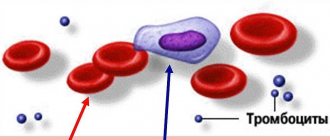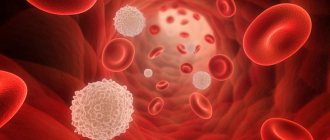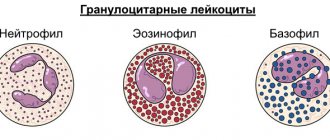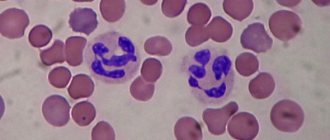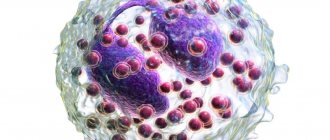The composition of human blood is not static - it changes, and this depends on many factors. Everything from the time of day to the individual characteristics of the body, for example: reactions to hot weather, can affect it. To assess how healthy a person is, all indicators must be taken into account. A complete blood test will help assess your health. And if there are low leukocytes, low platelets, you need to consult a hematologist. Especially if the indicators differ from the norm.
There is no point in delaying a visit - this is the case when a timely visit saves a life.
Leukocytes
Leukocytes are white blood cells that provide protection to the body from pathogenic pathogens. Formed by bone marrow. When an infection or virus enters, the body produces an increased number of white blood cells. They attack the pathogen and dissolve it. And they die themselves. New cells are produced instead of dead ones, and this is how balance is maintained.
Relative norm of leukocytes:
- For adults – 4-9·109/l.
- For newborns from 9 to 30·109/l.
- For children aged 1-3 years 6.0-17.0·109/l.
- For children aged 6-10 years 6.0-11.0·109/l.
- Children over 10 years old are eligible for the adult category.
The number of leukocytes in the blood is not constant. The indicators change, for example: the level increases in the evening or after physical activity, after a heavy meal, a sauna or drinking alcohol.
A decrease in the level of white blood cells is called leukopenia.
Leukopenia
The term "leukopenia" is not an indicator of the disease. It refers to a medical condition in which the white blood cells in the blood are low. This is a serious condition that signals the presence of major problems.
There are 2 causes of leukopenia:
- Destruction of leukocytes. Possible reasons:
- Chronic infection. Due to its constant suppression, the immune system weakens. When a parallel disease develops, there are not enough leukocytes to fight it.
- Severe infection. When there are not enough leukocytes produced to suppress it.
- Worms. Neutrophils accumulate in the habitat of protozoa and do not respond to other pathogens.
- Viral disease.
- Thyrotoxicosis, high levels of thyroid hormone.
- Viral hepatitis.
- Lymphogranulomatosis.
- Syphilis.
- Damage to the liver or spleen.
- Autoimmune diseases.
- Shock.
- Leukocytes are not formed. Causes:
- Congenital disease.
- HIV AIDS.
- Autoimmune disorders in which white blood cells attack the bone marrow.
- Radiation sickness in acute or chronic form.
- Bone marrow cancer or metastases from other organs.
- Vitamin deficiency.
Lack of leukocytes weakens the body's defenses. And any disease, even a simple acute respiratory infection, lasts long and painfully and gives complications. Regular flu leads to pneumonia, and treatment does not guarantee results. Any attempt to “handle” a sore throat is fraught with consequences.
Information for patients with leukopenia and thrombocytopenia
When leukopenia and/or thrombocytopenia is confirmed in a patient after a diagnostic study, the hematologist is obliged to convey important and vital information to the patient. The fact that the body’s protective function is weak due to a decrease in the number of the main pest fighters - leukocytes. The patient should not eat uncooked meat or drink raw water. Buy juices and dairy products only from factory-made products that have undergone the pasteurization process. Vegetables and fruits must be thoroughly washed and preferably treated with boiling water. When a patient visits public places: transport, city organizations, supermarkets, he should wear a mask and, if possible, avoid communicating with people sick with acute respiratory infections and flu. If a patient, despite following all the rules, experiences a rapid pulse, headaches, or an increase in body temperature, you should urgently go to a medical facility, call a doctor and an ambulance. As a rule, after the appearance of such symptoms, emergency hospitalization is required.
Symptoms of lack of leukocytes
Leukopenia is an acute condition. It is impossible not to notice her. Due to the fact that leukocytes are low, a person constantly experiences a condition similar to a cold. When you are “about to get sick.” But you don’t get sick, but the condition remains. Typical symptoms include:
- Persistent increase or decrease in body temperature. Daily fluctuations are possible, for example: an increase in the evening due to the fatigue accumulated during the day. Lowering - in the morning, before breakfast.
- Constant weakness, malaise, drowsiness. Symptoms are not related to daily activity.
- Decreased appetite, weight loss. Weight loss may be slight and loss of appetite may not be noticeable. Usually the signs are ominous, and if the weight decreases significantly, you need to see a doctor.
- Headache and heavy sweating. Sweat is not related to ambient temperature. Possible night sweats.
- Cold symptoms that do not go away and are not treated with regular remedies.
- Joint pain. In an adult, those that bear significant loads.
- Enlarged lymph nodes, primarily in the neck. Lymph nodes are mobile, dense and not painful.
- Pustular rashes on the body.
Possibly asymptomatic. But general oppression and depression are present. If some of the listed signs are present, in order to exclude low white blood cells, it is necessary to take a general blood test.
It is important to find out what disease caused the decrease in leukocytes. For some of them, for example: for autoimmune and hereditary ones, there is no treatment. But preventing infections, proper nutrition and following doctor's recommendations prevent the development of diseases.
Reduced platelets and leukocytes: causes, signs and danger of deviations in indicators
Blood is the source of life, but it can also cause disease. Because the composition of blood is never the same, changes in this fluid can indicate the presence of various health problems. This is the basis for a blood test, by which the doctor judges the well-being or disorders in various organs.
The value and norm of platelets in the blood
Platelets are the smallest blood cells
There is a concept of normal indicators, significant deviations from which in one direction or another are interpreted as signs of various diseases. These interpretations are related to which particular indicator has been changed.
For example, if platelets and white blood cells are low, doctors will conduct more in-depth studies, since these conditions indicate many different reasons for the decrease in indicators.
It should be noted that slight increases or decreases in data relative to the norm are not signs of disease, since fluctuations in the state of the blood are possible for reasons that have nothing to do with the disease.
Platelets may increase when dehydrated and decrease after taking certain medications.
Platelets in the blood are responsible for its coagulation and the formation of a clot - a thrombus. This is an important indicator that may indicate various disorders in the hematopoietic system and the presence of diseases.
The following platelet counts by age are considered normal:
| Age group | Relative norm |
| Newborns | 100 – 400*109/l |
| Children | 160-320*109/l |
| Pregnant women | 150-380*109/l |
| Adults | 180-320*109/l |
A pronounced decrease in indicators relative to the norm is called thrombocytopenia. This is not a disease, but only a symptom of trouble in the body, the causes of which must be found out in order to normalize the indicators.
Causes and signs of thrombocytopenia
Thrombocytopenia is characterized by increased bleeding
If platelets and leukocytes in the blood are low, the doctor will prescribe a series of examinations, focusing on the existing signs. With a low platelet count, the blood cannot clot normally, and in a person, even minor damage to the skin is accompanied by quite severe bleeding.
This condition can be very dangerous for people who have ulcerative lesions of the digestive system, pregnant women during childbirth, people preparing for surgery, if they are involved in an accident, and so on.
It is believed that there are three main causes for a decrease in platelet count:
- Cell destruction. It can be caused by autoimmune diseases, poisoning, severe intoxication, renal failure in a state of decompensation, Wergolf's disease, after heart valve replacement or hemodialysis, as a result of hemolysis due to blood transfusion.
- Insufficient production of platelets in the body. Occurs in the following conditions and diseases: leukemia, treatment of oncology with chemotherapy, radiation sickness, as a consequence of the use of certain medications, due to an acute lack of B vitamins and/or folic acid, due to bone marrow diseases.
- Abnormal distribution of platelets between the blood, spleen and liver. This condition is caused by significant enlargement of the liver and/or spleen, heart failure, or cirrhosis of the liver.
In rare cases, a congenital form of thrombocytopenia is observed, caused by an inherited mutated gene. This disease is called hemophilia and it threatens the patient with death even due to minor injury.
With thrombocytopenia, the patient suffers from severe bleeding from minor scratches, he has bleeding from the gums in the absence of diseases of the oral cavity, a tendency to nasal and uterine bleeding, eyes “flooded” with blood without increasing intraocular or blood pressure, a tendency to form extensive bruises and bruises even from light touch.
Functions and norm of leukocytes in the blood
Leukocytes are white blood cells
Leukocytes are the main defenders of the human body, the vanguard of the immune system. They are produced by the bone marrow, and when an infection enters the body or various injuries occur, their production increases sharply. Leukocytes literally, at the cost of their lives, attack the enemy and eliminate it. New cells are immediately produced to replace dead cells, so that the body remains protected.
If there are few white cells in the blood, this indicates significant disturbances in the functioning of the hematopoietic organs or the presence of a number of lesions and diseases.
The following indicators are considered normal:
| Age group | Normal values, /l |
| Newborns | 9–30*109 |
| Children 12 – 36 months | 6–17*109 |
| Children from 6 to 10 years old | 6–11*109 |
| Children over 10 years old and adults | 4–9*109 |
Read: RBC blood test and its interpretation
A slight decrease in the level of leukocytes relative to the norm is not a reflection of the disease. It can appear after intense sports activities, physical fatigue, when visiting a bathhouse or sauna, after heavy libations and feasts.
Causes and symptoms of leukopenia
If platelets and leukocytes are low, a more thorough examination of the patient is necessary. Low levels of white cells are called leukopenia and are not a disease in their own right.
Leukopenia can be a sign of a number of serious diseases, and even cancer
She points to the following reasons:
- Destruction of leukocytes in the body. It can be triggered by a severe or chronic infection, viral attack, helminthic infestation, thyrotoxicosis, viral hepatitis, lymphogranulomatosis, liver and spleen dysfunction, syphilis, autoimmune diseases or severe shock.
- The body does not produce white blood cells or produces too few of them. This condition is provoked by radiation exposure, acute lack of vitamins, autoimmune diseases, congenital problems, immunodeficiency and AIDS, malignant bone marrow lesions or the presence of metastases.
If the body does not have enough white cells, this means that it cannot fully fight even a basic infection. A weakened immune system cannot cope with its function, and such a person remains practically defenseless against any disease.
More information about general blood test indicators can be found in the video:
Leukopenia occurs in a patient with symptoms that are very similar to a cold:
- Fluctuations in body temperature, it is either increased or decreased, low-grade fever is often observed, that is, the temperature stays at 37 - 37.5 C, and then begins to “jump” again.
- Weakness, feeling tired, lethargic, not caused by physical activity.
- Headache.
- Increased sweating, and a person is literally drenched in sweat without the slightest physical activity, even at rest. You may experience profuse night sweats.
- Decreased appetite accompanied by weight loss.
- Joint pain.
- Signs of a cold that cannot be treated with conventional methods.
- A pustular rash that can be distributed over different parts of the body.
- Enlarged lymph nodes, especially in the neck. To the touch they seem dense, mobile and do not cause discomfort.
A person may not feel pronounced symptoms, but in combination they manifest themselves as severe weakness, fatigue and a general depressed state. If a person suddenly begins to lose weight significantly, so much so that it becomes noticeable in a short period of time, contacting a doctor should be done immediately.
The dangers of low platelets and white blood cells
A complete blood count determines the level of platelets and leukocytes
In a situation where platelets and leukocytes are significantly reduced, this indicates the presence of serious disturbances in the functioning of the body. A low platelet count threatens the patient with bleeding, including the most dangerous – internal.
A low number of white blood cells indicates a sharp weakening of the immune system. In this condition, the body remains practically defenseless against the attacks of any infection. Even a common acute respiratory infection, not to mention the flu, can cause severe consequences and sometimes death.
Severe leukopenia and thrombopenia can have very serious causes.
Typically, such conditions indicate massive damage to internal organs, of which the most life-threatening are cancer.
One rule applies to them - the patient’s life can be saved only if the problem is detected early and proper treatment is promptly initiated. Then it is possible to achieve stable remission and recovery.
Otherwise, doctors will only be able to slightly prolong the patient’s life.
Even if the patient’s condition is not caused by oncology, there are many other dangerous serious diseases that require fast and high-quality treatment. Therefore, when receiving blood results with significantly reduced numbers of platelets and leukocytes, the patient must diligently undergo all the necessary examinations and tests, and then carefully follow the doctor’s instructions.
Source: https://DiagnozLab.com/analysis/clinical-tests/blood/ponizheny-trombotsity-i-lejkotsity.html
Platelets
Colorless, nuclear-free blood cells. There are two functions: blood clot formation and blood clotting. The role of platelets in tissue regeneration has recently been discovered.
Relative platelet rate:
- For adults – from 180·109
- For women during the menstrual cycle or pregnancy - up to 100 109
- For newborn children – 100-400 109
- For children – from 160·109
To analyze platelet levels, it is necessary to take into account subjective factors and the patient's condition.
If the platelets in the blood are low, the condition is called thrombocytopenia.
Thrombocytopenia
The term is general. Describes a condition and does not indicate a specific disease. A low platelet count is dangerous because it affects the blood's ability to clot. The fewer platelets, the worse the blood clots and the more dangerous any, even minor, bleeding is.
There are 3 causes of thrombocytopenia:
- Destruction of platelets. Possible reasons:
- Wergolf's disease - most platelets are destroyed. The reason is not clear.
- Autoimmune diseases.
- Severe poisoning and intoxication.
- As a result of hemodialysis or heart valve replacement.
- Hemolysis after blood transfusion.
- Decompensated renal failure.
- Few platelets are produced. Causes:
- Leukemia is the most common cause.
- Radiation sickness.
- As a result of chemotherapy.
- Lack of vitamin B and folic acid.
- Infections leading to bone marrow damage.
- As a result of side effects of certain medications.
- Incorrect distribution of platelets between the liver, spleen and blood. Possible reasons:
- The spleen is greatly enlarged.
- The liver is greatly enlarged.
- Cirrhosis of the liver.
- Heart failure.
In all cases, blood flow is obstructed. Liver and spleen - due to the increase in size, a large amount of blood accumulates in them. Therefore, enough platelets are produced, but their distribution is uneven.
There is congenital thrombocytopenia, which occurs as a result of mutation of internal organs. Symptoms usually appear from birth. The most well-known disease associated with bleeding disorders is hemophilia. This is a condition in which you can bleed from minor cuts. And the most famous patient in history who suffered from such a disease is Tsarevich Alexei Nikolaevich Romanov, heir to the Russian throne.
Reduced platelets and leukocytes: causes, signs and danger of deviations - Diagnostic
Platelets are low and white blood cells are low – what does this mean? The composition of the blood changes periodically and it happens that the test results contain low leukocytes and low platelets. These blood components are undoubtedly important and their changes always lead to different results.
Therefore, it is advisable to understand why they are needed and what consequences their fluctuations lead to. This will help avoid complications and get rid of the problem in a timely manner.
The interpretation of the results for each person will be individual, because the norm has a wide range and depends on many factors.
Norm of leukocytes and platelets
Basically, these indicators for men and women are not too different. But in children, the number of leukocytes and platelets is slightly different. But changes indicate the presence of problems in the body. They can be caused by various factors and affect a person in different ways.
Normally, the indicators look like this:
- leukocytes in adults - from 4.0·109;
- leukocytes in children - from 4.5·109;
- platelets in adults - from 180·109;
- platelets in children - from 160·109.
In newborns, in the first few days the level of leukocytes can be up to 32·109 U/l. Gradually over the years this level decreases and at 6 years is 4.5-5·109. In men, the average is slightly higher than 4.2 109 and gradually decreases with age to 3.9. In women, the normal level of leukocytes is 3.9. In old age it drops slightly and reaches 3.7.
Normal platelets in adults are not very different, but in women their levels are constantly changing. It is associated with menstruation and pregnancy. At this time, the indicator can reach 100·109. During the newborn period, the normal platelet count in a child ranges from 100 to 400·109. Gradually it changes and at 5-6 years it will have an indicator of 160-180·109.
The diagnosis is not made based on the number of leukocytes and platelets alone. To do this, it is necessary to take into account all indicators and take into account the characteristics of the body.
A clinical blood test will show the number of white blood cells, which are an important part of the immune system. They help in the body's fight against bacteria and viruses that penetrate it. Therefore, changes in the body always affect performance. There are several types of leukocytes, differing in their functional responsibilities.
There are three reasons for its appearance:
- Problems in the functioning of the bone marrow.
- Death of leukocytes.
- Lack of substances to create them.
The most common reason is the third. But the reductions in these cases are not so great and the indicators are more likely to approach the minimum norm. Together with them, you can notice a decrease in red blood cells and hemoglobin. This is not surprising, because the same substances are used for their synthesis.
With a lack of B vitamins, iron and copper, a gradual decrease in white blood cells occurs. This happens with poor nutrition.
To normalize the situation, it is enough to adjust the diet. If the body is not able to absorb these substances from food, then the doctor prescribes medications.
Another reason is the death of leukocytes. At the same time, they are produced in sufficient quantities, but die. This happens during the redistribution of leukocytes, when a local problem arises in the body. The immune system directs white blood cells to damaged tissue, which reduces their number in the circulating blood.
In case of disruption of the bone marrow, a significant decrease in the indicators of leukocytes of all subgroups is noticeable. This happens due to intoxication with poisons, heavy metals and even alcohol. Causes include chemotherapy for cancer, autoimmune diseases and radiation. The appearance of a tumor with metastases to the bone marrow also significantly reduces the level of leukocytes.
In all these cases, the drop will be very pronounced, so do not worry if a slight decrease in white blood cells is detected in the test results.
Causes of decreased platelets
When their level decreases, thrombocytopenia occurs. Adults and children can suffer from this, but the reasons for children are somewhat different. This is especially true for newborn babies.
Their decline occurs for a number of reasons:
- transimmune problems;
- prematurity;
- hemangioma;
- asphyxia;
- insufficient amount of hemoglobin;
- infectious diseases;
- immunodeficiency.
In older children, the cause of a decrease in the number of platelets is allergic reactions, viral infections, lack of folic acid in the body, or intoxication. In women, platelet reduction is caused by menstruation and pregnancy, so such physiological factors do not pose a threat. But some body problems can cause it in adults.
Among them:
- anemia;
- blood cancer;
- bone marrow disease or injury;
- large blood loss;
- heavy metal poisoning;
- autoimmune diseases;
- herpes;
- hemophilia.
Excessive alcohol consumption, some medications and infectious diseases affect the reduction. If a person has undergone hemodialysis, then he will also find a decrease in indicators. Taking blood thinning medications helps reduce platelets.
Consequences of declining performance
Consequences of leukopenia:
- increased frequency of colds;
- frequent occurrence of fungus;
- the body's vulnerability to viruses and bacteria;
- protracted and severe treatment of diseases.
A person becomes susceptible to various kinds of diseases. But even your own microorganisms can worsen the condition. Women may experience frequent relapses of thrush. If you have chronic diseases, they will only get worse and can spread to other organs.
The consequences of a decrease in platelets are no less terrible. In this case, the occurrence of hematomas is observed even with the slightest pressure, the frequent occurrence of prolonged nosebleeds or with wounds and scratches.
Women experience heavy and long periods. If the platelet count continues to decrease, internal organ bleeding may occur. This in some cases leads to death.
No one is completely immune from a decline in these indicators. Therefore, it is very important to monitor your health and take the necessary tests on time. This makes it possible to take timely measures to eliminate the causes or significantly reduce their impact on the body.
Source:
Leukopenia, thrombocytopenia: characteristics of diseases, methods of treatment
- Additional education:
- "Hematology"
- Russian Medical Academy of Postgraduate Education
- Contacts
A decrease in the number of a certain type of cell in the blood (cytopenia) is not a rare phenomenon in medical practice.
Quite often, adults and children, even newborns, have a low level of white blood cells (leukopenia) or platelets (thrombocytopenia). However, there is a simultaneous reduction in the number of leukocytes and platelets in the blood. This phenomenon is called bilinear cytopenia.
The rapid decrease in cells is due to the fact that they are destroyed during the process of hematopoiesis in the bone marrow or directly in the bloodstream.
The presence of leukopenia is indicated by repeated viral or bacterial infections, stomatitis, sore throat, cramping abdominal pain, diarrhea, flatulence, purulent inflammation of the hair follicle (furunculosis). Cases of anemia (low hemoglobin) are more associated with a decrease in red blood cells.
With leukopenia and thrombocytopenia, the patient’s body adapts to its new condition and hemoglobin decreases gradually. Although there are cases of aplastic anemia, in which there is a deficiency of three cell lines.
The importance of platelets and leukocytes in the body
Platelets are formed by the detachment of sections of cytoplasm from megakaryocytes, which are located in the bone marrow. Platelets live in the blood for up to 11 days, and then disintegrate in the liver and spleen.
These small but very useful cellular elements stop bleeding and restore blood vessels. We observe the work of platelets when we receive injuries and wounds.
If platelets did not exist, blood would not clot, and then any injury would be fatal to a person.
Leukocytes protect the human body from external and internal negative influences; they are the basis of the immune system, the body’s protective barrier. Leukocytes, or white blood cells, absorb and digest foreign particles.
When an inflammatory process begins in the body, more and more leukocytes are recruited to help fight pests. In the fight against foreign bodies, leukocytes build a protective shield, which is sometimes damaged and some of the leukocytes die.
During inflammation, pus forms in the tissues; it is believed that these are dead leukocytes.
Causes of leukopenia and thrombocytopenia
A significant reduction in the number of platelets and leukocytes in the blood depends on many circumstances.
Leukopenia, thrombocytopenia and cytopenia (deficiency of one or even several blood cells) can be independent diseases or serve as a signal alert to the body about various pathologies of internal organs and systems. One way or another, leukopenia and thrombocytopenia occur as a result of certain factors:
- excessive consumption of alcohol, the active substance (ethyl alcohol) which entails a disruption in the performance of platelets and leukocytes;
- deficiency of vitamin B12 and folic acid;
- long-term fasting, which is often practiced by women in the fight against extra pounds or by lovers of alternative medicine;
- allergic reaction to medications (antibiotics, diuretics, anticonvulsants, antidiabetic and anti-inflammatory drugs);
- viral and bacterial infections (hepatitis A, B and C, typhoid fever, brucellosis (an infectious disease of domestic animals), pulmonary tuberculosis);
- hereditary diseases;
- stress;
- acute leukemia;
- sepsis;
- HIV infection;
- cirrhosis of the liver (the spleen increases in size and anemia appears);
- Addison-Beermer disease (vitamin B12 deficiency);
- endocrine diseases: acromegaly (enlargement and expansion of the hands and feet),
- chronic deficiency of the adrenal cortex;
- chronic inflammatory process of the colon, gastric mucosa;
- cancer metastases;
- radiation;
- aplastic anemia.
Symptoms of diseases
Since platelets are responsible for blood clotting and monitor the condition of blood vessels, and leukocytes fight pests in the body, important symptoms of thrombocytopenia and leukopenia are hemorrhages, fever, rapid pulse and headaches.
Hemorrhages are most often observed in the gastrointestinal and mucous membranes, as well as nasal and uterine bleeding, and increased bleeding of the gums.
With thrombocytopenia, bruises appear on the skin without any physical impact, a small rash all over the body, and blood is noticeable in the stool or urine.
With leukopenia, the body's protective functions decline, pest fighters become fewer and fewer, and blood infection occurs. Inflammatory processes in the oral cavity and pneumonia are also observed.
Although the danger of conditions threatening the body is growing (anemia, cerebral hemorrhages).
Diagnostic examination
To begin with, if leukopenia and/or thrombocytopenia is suspected, it is necessary to do a laboratory test of a complete blood count to calculate the number of all types of cells in the blood. However, with the help of this study it will only be possible to determine the number of platelets; with leukocytes it will be more difficult.
Since in a number of diseases the number of leukocytes remains normal, but the level of the most numerous group of leukocyte cells - neutrophils - decreases sharply. Therefore, when diagnosing the disease, an absolute count of neutrophils, not leukocytes, is necessary.
Then, in order to establish the cause and mechanism of development of the disease, a diagnosis should be made:
- determination of blood clotting time;
- puncture of the red brain;
- genetic research;
- ultrasonography;
- perform liver tests;
- examine the level of vitamin B12 in the body;
- magnetic resonance imaging (MRI).
Source: https://mrt86.ru/ultrazvukovoe-issledovanie-uzi/ponizheny-trombotsity-i-lejkotsity-prichiny-priznaki-i-opasnost-otkloneniya-pokazatelej.html
Symptoms of platelet deficiency
Due to the peculiarity of the main function of platelets, the symptoms manifest themselves clearly. And the sick person quickly consults a doctor. Symptoms of the condition include:
- Prolonged bleeding due to minor cuts.
- Formation of large bruises after minor injuries. Such bruises last a long time and disappear.
- With a healthy oral cavity, gums bleed.
- Small subcutaneous hemorrhages, which eventually merge into one large spot.
- Frequent nosebleeds.
- Frequent hemorrhages in the conjunctiva of the eye without increased blood pressure.
- Long and heavy menstruation in women. Uterine bleeding.
Usually a slight decrease in platelets goes unnoticed. The above symptoms are characteristic of severe thrombocytopenia. To identify and eliminate problems in a timely manner, it is best to take a general blood test once a year.
Consequences of declining performance
If you do not pay attention to the decrease in white blood cells and platelets, unpleasant consequences are possible. First of all, the severity of these consequences will depend on the magnitude of the reduction. The greater it is, the more difficult it will be for a person. Thus, a decrease in leukocytes leads to a decrease in immunity, and a decrease in platelets leads to bleeding. Consequences of leukopenia:
- increased frequency of colds;
- frequent occurrence of fungus;
- the body's vulnerability to viruses and bacteria;
- protracted and severe treatment of diseases.
A person becomes susceptible to various kinds of diseases. But even your own microorganisms can worsen the condition. Women may experience frequent relapses of thrush. If you have chronic diseases, they will only get worse and can spread to other organs.
The consequences of a decrease in platelets are no less terrible. In this case, the occurrence of hematomas is observed even with the slightest pressure, the frequent occurrence of prolonged nosebleeds or with wounds and scratches. Women experience heavy and long periods. If the platelet count continues to decrease, internal organ bleeding may occur. This in some cases leads to death.
No one is completely immune from a decline in these indicators. Therefore, it is very important to monitor your health and take the necessary tests on time. This makes it possible to take timely measures to eliminate the causes or significantly reduce their impact on the body.

